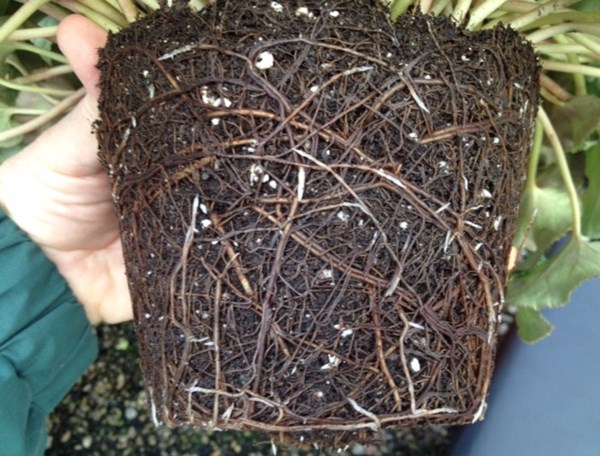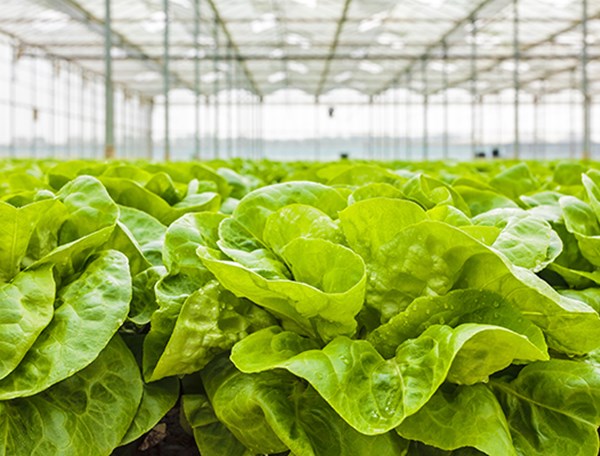Training Center
Water Sanitation Part 3a: Oxidizers Used for Water Sanitation
Thursday, September 7, 2023 | Lance Lawson
In part 2, we discussed the importance of “preparing” irrigation water for sanitation. This involved removal of total suspended solids, reduction of biofilm in pipes and tanks and consideration of water pH and electrical conductivity. All these factors influence the application rate and efficacy of a sanitizing agent. Now in this final part, we will discuss different types of sanitizing agents, how they work and some of the advantages and disadvantages of each. As many have found, there is not one system that works best for all growers. This article will focus on oxidizing agents used to sanitize greenhouse irrigation water and the second half, which will be in the next Grower Services Newsletter, will focus on other methods to sanitize water.
Oxidizing agents
Oxidizing agents are added to irrigation water to kill pathogens by direct exposure to the agent for a specified length of time. The length of exposure required to kill pathogens depends on the pathogen itself, its inoculum structure, the type and concentration of the oxidizing agent and biological load in the water.
An advantage of most oxidizing agents is that there is residual product that persists in the water. Therefore, if the ‘sanitized’ irrigation water becomes re-contaminated with a pathogen before reaching the crop, it can control the pathogen. Oxidizing agents work well, but are often ‘used up’ in organic media components, such as peat, bark, compost and coir as well as algae, plant debris, biofilm and of course, pathogens. It is critical that water is filtered and cleaned in order for an oxidizing agent to effectively control pathogens in water. Also consider that oxidizers react and bind with iron, manganese, boron and other metals found in the water, also reducing their efficacy.
The most common oxidizing agents used to clean irrigation water will be discussed in the following chart below. These are chlorine gas, chlorine dioxide, calcium hypochlorite, sodium hypochlorite, ozone and activated peroxygen.
| Sanitazer (Active Ingredient) | Delivery into water | Rate | Comments |
| Chlorine gas (CI2) | Chlorine gas is bubbled into water where it combines with water to form hypochlorus acid(HOCI) or hydrochloric acid (HCI). | 0.5-2.0 ppm free chlorine. 2 ppm controls zoospores of many Pythium and Phytophtora species. | Lowest cost form of chlorine per ppm. Chlorine gas stored in a cylinder, so no pre-mixing is required. Hazardous gas requiring special equipment, ventilation and handling. Exceeding 2 ppm free chlorine in the water can be phytotoxic to plants. Ideal water pH 6.0-7.5 (below 4 it gases off, above 7.5 it is less effective). Metals such as Fe, Mn, B, Cu, etc. And organic matter can tie up free chlorine. |
| Chlorine Dioxide (CIO2) | Gas injected into water forming a concentred stock solution of CIO2, then it is injected. | 0.25 ppm or less CIO2 residual (1 ppm CIO2 may be required for some bacteria). | Chlorine dioxide moves freely withing water making it effective at controlling biofilm. Effective at apH of 4-10. Not as sensitive to organic matter as other chlorine sources. Often requires equipment to make chlorine dioxide on the premises. Should use stock solution within 15 days to minimize loss from volatilization. can be phytotoxic at high rates. Forms precipitates with metals (fe, Mn, B, Cu, etc.). |
| Calcium Hypochlorite (Ca(OCI)2) | Granules or tablets are weathered with a small amount of irrigation water that is bypassed through the chlorinator. A gate controls the ppm CI2 rate. | 0.5-2.0 ppm free chlorine. 2 ppm controls zoospores of many Pythium and Phytophtora species. | Safer than chlorine gas and sodium hypochlorite. Easier to store and less corrosive than other chlorine forms. Granular and tablets dissolve at slower rates as water temperature drops. Exceeding 2 ppm free chlorine can be phytotoxic to plants. Ideal water pH 6.0-7.5 (below 4 it gases off, above 7.5 it is less effective). Metals and organic materials in water can tie up free chlorine. Can produce cloudiness and sediment if free chlorine concentrate exceeds 200 ppm CI2. |
| Sodium Hypochlorite (NaOCI) | Liquid sodium hypochlorite (5-15% chlorine) is injected directly into water. Also known as bleach. | 0.5-2.0 ppm free chlorine. 2 ppm controls zoosphores of many Pythium and Phytophtora species. | Easy to apply though injection. Exceeding 2 ppm free chlorine can be phytotoxic to plants. Ideal water pH 6.0-7.5 (below 4 it gases off, above 7.5 it is less effective). Metals and organic matter can tie up free chlorine. Requires a corrosion resistant injector. Has limited shelf life - use within 1-2 months - warm temperatures and sunlight speed up degradation. |
| Ozone (O3) | Generated on site with an electric arc and then bubbled through water. | Injection rate <1 ppm O3, residual activity of 0.01-0.2 ppm O3. Residual at or above 1 ppm O3 may be phytotoxic. | No raw materials needed and no waste created. High initial set up cost, but low operating cost. Has to be professional;y designed to prevent hazardous levels of ozone from escaping from water. Best to inject into water in enclosed tank, ozone should be in contact with water for 20-60 min. 0.2 ppm O3 can destroy biofilm if held for 30 minutes. Short lived residual activity in water, ideal pH = 4 and cold water temperature provide the best shelf life decreases. Will oxidize metals in water creating precipitates. Filter water to remove organic materials as they reduce efficacy. Difficult to monitor as ozone degrades quickly. |
| Hydrogen Peroxide/Hydrogen dioxide (H2O2) and Peroxyacectic acid/Peracetic acid (CH3COO-OH) | Both types are injected directly into water. | Depends on manufacturer but range is 27-540 ppm H2O2. | No toxic waste produced- only carbon dioxide, hydrogen and oxygen- and is environmentally friendly. Easy to use, but corrosive, so special injectors are needed. Peroxyacetic acid/ peracetic acid are more effective biocides and more stable in water than hydrogen peroxide / hydrogen dioxide. Organic matter greatly reduces efficacy, forms precipitates with metals and the ideal water pH is below 7. More effective at warmer temperatures. UV ligh will degrade these products. |
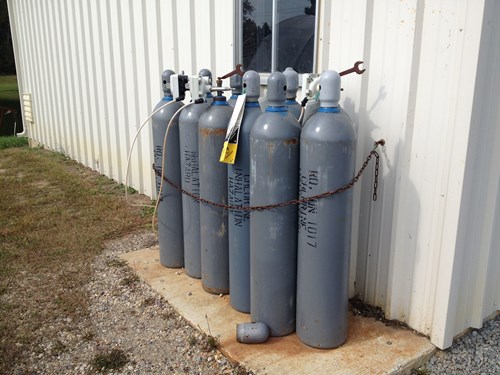
Chlorine gas cylinders supply the chlorine gas that is injected into the irrigation water to sanitize it. Source: Premier Tech.
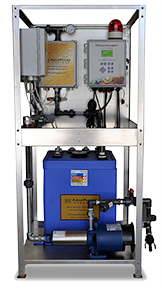
Chlorine dioxide generator for greenhouse water sanitation. Source: http://aquapulsechemicals.com/products.html.
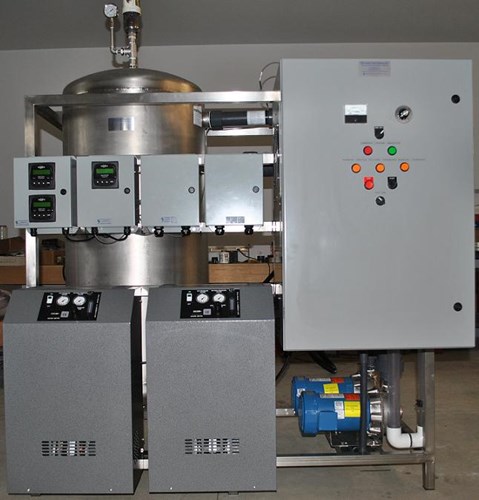
Ozone Generator for water sanitation. Source: http://www.climatecontrol.com
These oxidizing agents all have their own advantages and disadvantages. Whether you consider cost, residual effects, environmental hazards, worker safety, etc., not one system meets all these criteria. In the next edition of the Grower Services Newsletter, we will continue presenting the remaining types of water sanitation methods that are currently offered today to sanitize irrigation water for plants.
References:
- Konjoian, P. 2011. Chlorine Dioxide in Horticulture: A Technology Review. Greenhouse Grower March 17, 2011
- Powell, C.C. 2001. "Are Your Plants Drinking Dirty Water?" Grower Talks 79(7)
- http://pnwhandbooks.org/plantdisease/pesticide-articles/treating-irrigation-water-eliminate-water-molds
- Newman, S.E. 2004. "Disinfecting Irrigation Water for Disease Management." 20th Annual Conference on Pest Management on Ornamentals – Society of American Florist Meeting (San Jose, CA).
For more information, contact your Premier Tech Grower Services Representative:
 |
 |
 |
 |
|---|---|---|---|
|
Ed Bloodnick |
Nathan Wallace-Springer |
Lance Lawson |
Victor Brantly |
 |
 |
 |
|
|
Troy Buechel |
Susan Parent |
Jose Chen Lopez |
PRO-MIX® is a registered trademark of PREMIER HORTICULTURE Ltd.
Related Articles
-
Water Sanitation Part 1: Biology of Pathogens in Water Sources
Sanitation is a key to restricting plant pathogen introduction and spread. In this first of a three part series on water sanitation, we will discuss the importance of knowing the biology of root rot pathogens.
-
Water Sanitation Part 2: Pre-Treating Water Before Sanitation
We often think of water quality from the standpoint of chemical properties, such as alkalinity, mineral elements, pH, etc.

 Where to find our products
Where to find our products
